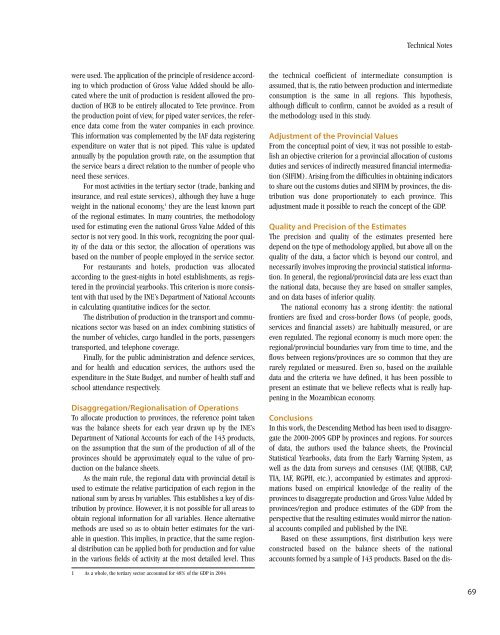English language version - Human Development Reports - United ...
English language version - Human Development Reports - United ...
English language version - Human Development Reports - United ...
- No tags were found...
You also want an ePaper? Increase the reach of your titles
YUMPU automatically turns print PDFs into web optimized ePapers that Google loves.
Technical NotesConclusionsIn this work, the Descending Method has been used to disaggregatethe 2000-2005 GDP by provinces and regions. For sourcesof data, the authors used the balance sheets, the ProvincialStatistical Yearbooks, data from the Early Warning System, aswell as the data from surveys and censuses (IAF, QUIBB, CAP,TIA, IAF, RGPH, etc.), accompanied by estimates and approximationsbased on empirical knowledge of the reality of theprovinces to disaggregate production and Gross Value Added byprovinces/region and produce estimates of the GDP from theperspective that the resulting estimates would mirror the nationalaccounts compiled and published by the INE.Based on these assumptions, first distribution keys wereconstructed based on the balance sheets of the nationalaccounts formed by a sample of 143 products. Based on the diswereused. The application of the principle of residence accordingto which production of Gross Value Added should be allocatedwhere the unit of production is resident allowed the productionof HCB to be entirely allocated to Tete province. Fromthe production point of view, for piped water services, the referencedata come from the water companies in each province.This information was complemented by the IAF data registeringexpenditure on water that is not piped. This value is updatedannually by the population growth rate, on the assumption thatthe service bears a direct relation to the number of people whoneed these services.For most activities in the tertiary sector (trade, banking andinsurance, and real estate services), although they have a hugeweight in the national economy, 1 they are the least known partof the regional estimates. In many countries, the methodologyused for estimating even the national Gross Value Added of thissector is not very good. In this work, recognizing the poor qualityof the data or this sector, the allocation of operations wasbased on the number of people employed in the service sector.For restaurants and hotels, production was allocatedaccording to the guest-nights in hotel establishments, as registeredin the provincial yearbooks. This criterion is more consistentwith that used by the INE’s Department of National Accountsin calculating quantitative indices for the sector.The distribution of production in the transport and communicationssector was based on an index combining statistics ofthe number of vehicles, cargo handled in the ports, passengerstransported, and telephone coverage.Finally, for the public administration and defence services,and for health and education services, the authors used theexpenditure in the State Budget, and number of health staff andschool attendance respectively.Disaggregation/Regionalisation of OperationsTo allocate production to provinces, the reference point takenwas the balance sheets for each year drawn up by the INE’sDepartment of National Accounts for each of the 143 products,on the assumption that the sum of the production of all of theprovinces should be approximately equal to the value of productionon the balance sheets.As the main rule, the regional data with provincial detail isused to estimate the relative participation of each region in thenational sum by areas by variables. This establishes a key of distributionby province. However, it is not possible for all areas toobtain regional information for all variables. Hence alternativemethods are used so as to obtain better estimates for the variablein question. This implies, in practice, that the same regionaldistribution can be applied both for production and for valuein the various fields of activity at the most detailed level. Thusthe technical coefficient of intermediate consumption isassumed, that is, the ratio between production and intermediateconsumption is the same in all regions. This hypothesis,although difficult to confirm, cannot be avoided as a result ofthe methodology used in this study.Adjustment of the Provincial ValuesFrom the conceptual point of view, it was not possible to establishan objective criterion for a provincial allocation of customsduties and services of indirectly measured financial intermediation(SIFIM). Arising from the difficulties in obtaining indicatorsto share out the customs duties and SIFIM by provinces, the distributionwas done proportionately to each province. Thisadjustment made it possible to reach the concept of the GDP.Quality and Precision of the EstimatesThe precision and quality of the estimates presented heredepend on the type of methodology applied, but above all on thequality of the data, a factor which is beyond our control, andnecessarily involves improving the provincial statistical information.In general, the regional/provincial data are less exact thanthe national data, because they are based on smaller samples,and on data bases of inferior quality.The national economy has a strong identity: the nationalfrontiers are fixed and cross-border flows (of people, goods,services and financial assets) are habitually measured, or areeven regulated. The regional economy is much more open: theregional/provincial boundaries vary from time to time, and theflows between regions/provinces are so common that they arerarely regulated or measured. Even so, based on the availabledata and the criteria we have defined, it has been possible topresent an estimate that we believe reflects what is really happeningin the Mozambican economy.1 As a whole, the tertiary sector accounted for 48% of the GDP in 200469
















